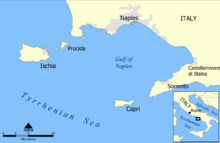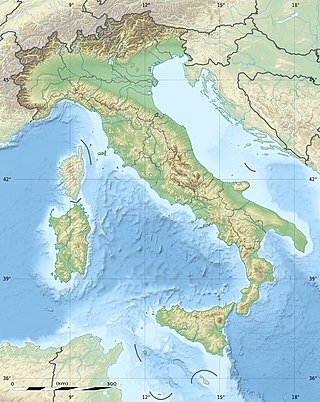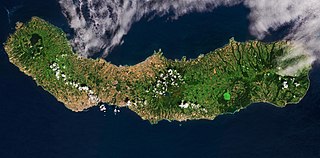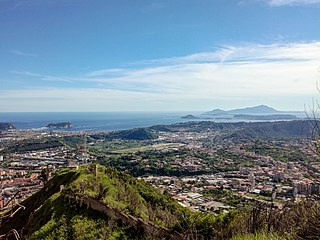 | |
| Geography | |
|---|---|
| Location | Tyrrhenian Sea |
| Administration | |
Italy | |
| Region | Campania |
| Province | Naples |
Vivara is a satellite islet of Procida, one of the three main islands in the Gulf of Naples. (The other two are Ischia and Capri.)
 | |
| Geography | |
|---|---|
| Location | Tyrrhenian Sea |
| Administration | |
Italy | |
| Region | Campania |
| Province | Naples |
Vivara is a satellite islet of Procida, one of the three main islands in the Gulf of Naples. (The other two are Ischia and Capri.)

Vivara flanks Procida to the south-west and is connected to it by a bridge. Vivara is a crescent-shaped remnant ridge of an ancient volcanic crater, part of the Phlegraean Fields. It is now a nature reserve of 35.63 hectares (88 acres), established under D.M. 24.06.02. In 1905, Giuseppe De Lorenzo described it thus:
What remains without darkness and without mysteries, outside the doubt and eternal uncertainty of scientific analysis, limpid and clear in the light of day, is the pure aesthetic vision of the crater Vivara, rising from the crashing sea with a sweet and harmonious form, its cliffs hues of hot colours, expressing from her breast a green mantle of herbs and plants, on which laughs a perpetual spring.
Archaeological digs[ when? ] have uncovered fragments of Mycenaean/Late Helladic pottery together with Proto-Apennine and Apennine material, pointing to a Middle Bronze Age trading site (emporium). Surveys around the coast, have established sunken coastal installations, pointing to extensive fishing and trading facilities, now up to 18m below the waterline. It is assumed that the lowest of these installations predate the Avellino eruption of Vesuvius, while some of the later ones may be associated with the Late Helladic material found elsewhere around the island. [1]

The geography of Italy includes the description of all the physical geographical elements of Italy. Italy, whose territory largely coincides with the homonymous geographical region, is located in southern Europe and comprises the long, boot-shaped Italian Peninsula crossed by the Apennines, the southern side of Alps, the large plain of the Po Valley and some islands including Sicily and Sardinia. Italy is part of the Northern Hemisphere. Two of the Pelagie Islands are located on the African continent.

A volcano is a rupture in the crust of a planetary-mass object, such as Earth, that allows hot lava, volcanic ash, and gases to escape from a magma chamber below the surface.

Mount Vesuvius is a somma-stratovolcano located on the Gulf of Naples in Campania, Italy, about 9 km (5.6 mi) east of Naples and a short distance from the shore. It is one of several volcanoes forming the Campanian volcanic arc. Vesuvius consists of a large cone partially encircled by the steep rim of a summit caldera, resulting from the collapse of an earlier, much higher structure.

The Apennines or Apennine Mountains are a mountain range consisting of parallel smaller chains extending c. 1,200 km (750 mi) along the length of peninsular Italy. In the northwest they join with the Ligurian Alps at Altare. In the southwest they end at Reggio di Calabria, the coastal city at the tip of the peninsula. Since 2000 the Environment Ministry of Italy, following the recommendations of the Apennines Park of Europe Project, has been defining the Apennines System to include the mountains of north Sicily, for a total distance of 1,500 kilometres (930 mi). The system forms an arc enclosing the east side of the Ligurian and Tyrrhenian Seas.

Tektites are gravel-sized bodies composed of black, green, brown or grey natural glass formed from terrestrial debris ejected during meteorite impacts. The term was coined by Austrian geologist Franz Eduard Suess (1867–1941), son of Eduard Suess. They generally range in size from millimetres to centimetres. Millimetre-scale tektites are known as microtektites.

Whakaari / White Island, also known as White Island or Whakaari, is an active andesite stratovolcano situated 48 km (30 mi) from the east coast of the North Island of New Zealand, in the Bay of Plenty. The island covers an area of approximately 325 ha, which is just the peak of a much larger submarine volcano.

Ischia is an Italian island in the Tyrrhenian Sea. It lies at the northern end of the Gulf of Naples, about 30 km (19 mi) from Naples. It is the largest of the Phlegrean Islands. Roughly trapezoidal in shape, it measures approximately 10 km (6 mi) east to west and 7 km (4 mi) north to south and has about 34 km (21 mi) of coastline and a surface area of 46.3 km2 (17.9 sq mi). It is volcanic and almost entirely mountainous; the highest peak is Mount Epomeo, at 788 m (2,585 ft). The island is very densely populated, with 62,000 residents.

São Miguel Island, nicknamed "The Green Island", is the largest and most populous island in the Portuguese archipelago of the Azores. The island covers 760 km2 (290 sq mi) and has around 140,000 inhabitants, with 45,000 people residing in Ponta Delgada, the archipelago's largest city.

The volcanism of Italy is due chiefly to the presence, a short distance to the south, of the boundary between the Eurasian Plate and the African Plate. Italy is a volcanically active country, containing the only active volcanoes in mainland Europe. The lava erupted by Italy's volcanoes is thought to result from the subduction and melting of one plate below another.

Procida is one of the Flegrean Islands off the coast of Naples in southern Italy. The island is between Cape Miseno and the island of Ischia. With its tiny satellite island of Vivara, it is a comune of the Metropolitan City of Naples, in the region of Campania.
The Apennine culture is a technology complex in central and southern Italy from the Italian Middle Bronze Age. In the mid-20th century the Apennine was divided into Proto-, Early, Middle and Late sub- phases, but now archaeologists prefer to consider as "Apennine" only the ornamental pottery style of the later phase of Middle Bronze Age (BM3). This phase is preceded by the Grotta Nuova facies and by the Protoapennine B facies and succeeded by the Subapennine facies of 13th-century. Apennine pottery is a burnished ware incised with spirals, meanders and geometrical zones, filled with dots or transverse dashes. It has been found on Ischia island in association with LHII and LHIII pottery and on Lipari in association with LHIIIA pottery, which associations date it to the Late Bronze Age as it is defined in Greece and the Aegean.

The Phlegraean Fields is a large region of supervolcanic calderas situated to the west of Naples, Italy. It was declared a regional park in 2003. The area of the caldera consists of 24 craters and volcanic edifices; most of them lie under water. Hydrothermal activity can be observed at Lucrino, Agnano and the town of Pozzuoli. There are also effusive gaseous manifestations in the Solfatara crater, the mythological home of the Roman god of fire, Vulcan. This area is monitored by the Vesuvius Observatory. It is considered a supervolcano.

Salina is one of the Aeolian Islands north of Sicily, Southern Italy. It is the second largest island in the archipelago.

The Phlegraean Islands are an archipelago in the Gulf of Naples and the Campania region of southern Italy.
The Campanian Archipelago, also called Neapolitan Archipelago, is an archipelago in the Tyrrhenian Sea, in southwestern Italy. It principally comprises 5 islands: Capri, Ischia, Nisida, Procida, and Vivara. Most of the archipelago belongs to the Metropolitan City of Naples.
First Crater is a volcanic crater on Arrival Heights, located 0.75 nautical miles (1.4 km) north of Hut Point on Ross Island. It was named by Frank Debenham in 1912 on his local survey of Hut Point Peninsula during the British Antarctic Expedition, 1910–13.
Twin Crater is a volcanic crater with twin nested cones that rises behind McMurdo Station and 0.5 nautical miles (0.9 km) west of Crater Hill on Hut Point Peninsula, Ross Island. This crater was named Middle Crater by Frank Debenham of the British Antarctic Expedition, 1910–13, apparently for its location in relation to First Crater and Crater Hill, but the name has fallen into disuse. Twin Crater, alluding to the nested cones in the crater, was applied as early as 1971 and the name has become established because of consistent use in current maps and reports. Black Knob, a big black rock outcrop lies 0.2 nautical miles east of Twin Crater.
Second Crater is a volcanic crater on Arrival Heights, situated 0.6 nautical miles (1.1 km) northeast of First Crater on Hut Point Peninsula, Ross Island. Named by F. Debenham in 1912 on his local survey of Hut Point Peninsula during the British Antarctic Expedition, 1910–13.

Hadley–Apennine is a region on the near side of Earth's Moon that served as the landing site for the American Apollo 15 mission, the fourth crewed landing on the Moon and the first of the "J-missions", in July 1971. The site is located on the eastern edge of Mare Imbrium on a lava plain known as Palus Putredinis. Hadley–Apennine is bordered by the Montes Apenninus, a mountain range, and Hadley Rille, a meandering channel, on the east and west, respectively.

A volcanic crater lake is a lake in a crater that was formed by explosive activity or a collapse during a volcanic eruption.